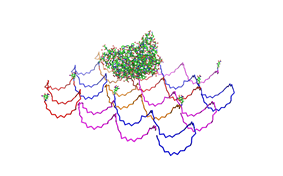DNA-Origami
From 2008.igem.org
(New page: {{Freiburg2008_Main| Content= <div style="font-size:18pt;"> <font face="Arial Rounded MT Bold" style="color:#010369">_DNA-Origami</font></div> <br><br> ==Introduction== Paul Rothemund has ...) |
WeberSimone (Talk | contribs) |
||
| Line 12: | Line 12: | ||
==Literature== | ==Literature== | ||
*Paul W. K. Rothemund: Nature 440, 297-302 (16 March 2006) | *Paul W. K. Rothemund: Nature 440, 297-302 (16 March 2006) | ||
| + | <h1>Methods</h1> | ||
| + | <h2>Phage DNA<span style="font-weight: bold;"></span></h2> | ||
| + | <h3><span style="font-weight: bold;"></span><span | ||
| + | style="font-weight: bold;">Cell culture</span><br> | ||
| + | </h3> | ||
| + | 50 ml DYT-Medium, 50µl tetracycline (TET; 25 mg/ ml) and ER2738-cells | ||
| + | were shaken over night at 37°C. The overnight culture was diluted with | ||
| + | DYT to OD600=0.1 and shaken at 37°C until the culture had an OD600 | ||
| + | around 0.4. Each 50 ml of cell culture were inoculated with 5 µl | ||
| + | M13mp18 phage and shaken for 4 h at 37°C.<br> | ||
| + | <h3>Isolation of M13mp18 phage from cell culture</h3> | ||
| + | PEG/NaCl was used to precipitate the phages.<br> | ||
| + | <span style="font-weight: bold;">First precipitation</span><br> | ||
| + | Each 50 ml of cell culture were centrifuged at 5000 g for 20 min. While | ||
| + | the cell were centrifuged 1/7 volume of the supernatant PEG/NaCl (about | ||
| + | 7ml/50ml) was put in a new falcon tube. The phages stay in the | ||
| + | supernatant therefore the supernatant was carefully decanted to the | ||
| + | PEG/NaCl and mixed gently by inverting the tube. The mixture (Solution | ||
| + | 1) was left overnight at 4°C. <br> | ||
| + | Solution 1 was centrifuged at 5000 g for 20 min. Because the phage stay | ||
| + | in the pellet, the supernatant was removed and the pellet was | ||
| + | resuspended in 2 ml TBS-Buffer (Solution 2). Solution 2 was put in a | ||
| + | 1,5 ml Eppendorf tube and centrifuged (13200 rpm, 10 min). After the | ||
| + | centrifugation the phages stay in the supernatant.<br> | ||
| + | <span style="font-weight: bold;">Second precipitation</span><br> | ||
| + | 170 µl PEG/NaCl(~ 1/6 volume of supernatant) were put in a Eppendorf | ||
| + | tube. Supernatant was carefully decanted to the PEG/NaCl and mixed | ||
| + | gently by inverting the tube. The mixture (Solution 3) was left for 1 h | ||
| + | on ice. Solution 3 was centrifuged at 13200 rpm for 10 min.<br> | ||
| + | <h3>Define phage titers</h3> | ||
| + | The absorption of Solution 3 was measured on a Jasco V-550 UV/VIS | ||
| + | spectrometer at 269 nm. <br> | ||
| + | Phage titer was calculated as follows:<br> | ||
| + | <span style="font-style: italic;"><span | ||
| + | style="font-weight: bold;">Phage DNA</span> = | ||
| + | ((A269-A360) * 6 * 10^16 * dilution factor) / (number of bases in the | ||
| + | phage genom = 7249 bp)</span><br> | ||
| + | <h3>Isolation of the phage DNA </h3> | ||
| + | The phage DNA was isolated with QIAprep Spin M13-Kit (50) from QIAGEN | ||
| + | (Cat.No: 27704). <br> | ||
| + | DNA-concentration was quantified by Nano-drop photometer.<br> | ||
| + | <span style="font-weight: bold;"><br> | ||
| + | </span> | ||
| + | <h2><span style="font-weight: bold;">Origami</span></h2> | ||
| + | <h3><span style="font-weight: bold;"></span>Produce | ||
| + | the Origami<br> | ||
| + | </h3> | ||
| + | To produce the Origami we mixed each the M13mp18 DNA with the oligos, | ||
| + | water and TEA/MgAcetat (end concentration =12.5mM).<br> | ||
| + | <p class="MsoNormal"><span style="font-size: 10pt;" | ||
| + | lang="EN-GB"><o:p></o:p></span></p> | ||
| + | <p class="MsoNormal"><span style="font-size: 10pt;" | ||
| + | lang="EN-GB"><o:p> TABELLE 1</o:p></span></p> | ||
| + | <p class="MsoNormal"><span style="font-size: 10pt;" | ||
| + | lang="EN-GB"><o:p>TABELLE 2</o:p></span></p> | ||
| + | Various samples were | ||
| + | produced. For the sample with a ratio of 1:20 (DNA:Oligo) we used 4 nM | ||
| + | DNA and 80 nM of oligos. The Origami were produced in a eppendorf | ||
| + | Mastercycler personal. Therefore they were heated up to 95°C for 7 min | ||
| + | and slowly cooled down (0.3°C/s) to 20°C.<br> | ||
| + | Different sample were made:<br> | ||
| + | Sample 1:20, 1:10 and 1:5 without NIP, oligos without NIP were used <br> | ||
| + | Sample 1:20, 1:10 and 1:5 with NIP, all of the 7 oligos with NIP were | ||
| + | used -> origami with 7NIP<br> | ||
| + | Sample 1:5 with NIP and fluorophor, all of the 7 oligos with NIP and | ||
| + | the 2 oligos with the Alexa 488 were used.<br> | ||
}} | }} | ||
Revision as of 19:51, 28 October 2008
|
_DNA-Origami
IntroductionPaul Rothemund has discovered that it is possible to shape M13-Phage single-strand-DNA simply adding oligonucleotides that will work as „brackets“ when complementing the long single-strand. Literature
MethodsPhage DNACell culture
|
 "
"

